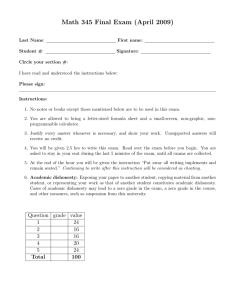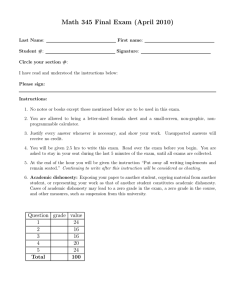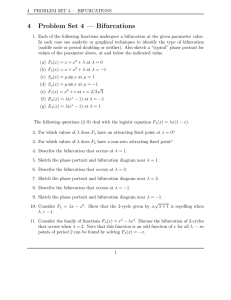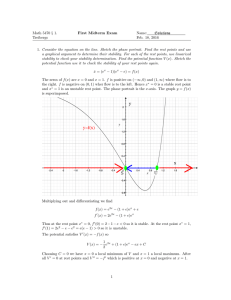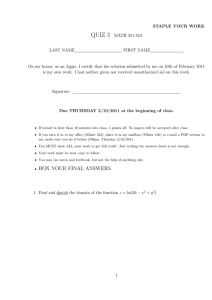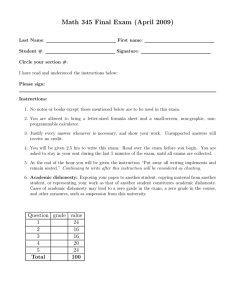Math 345 Final Exam (April 2009)
advertisement
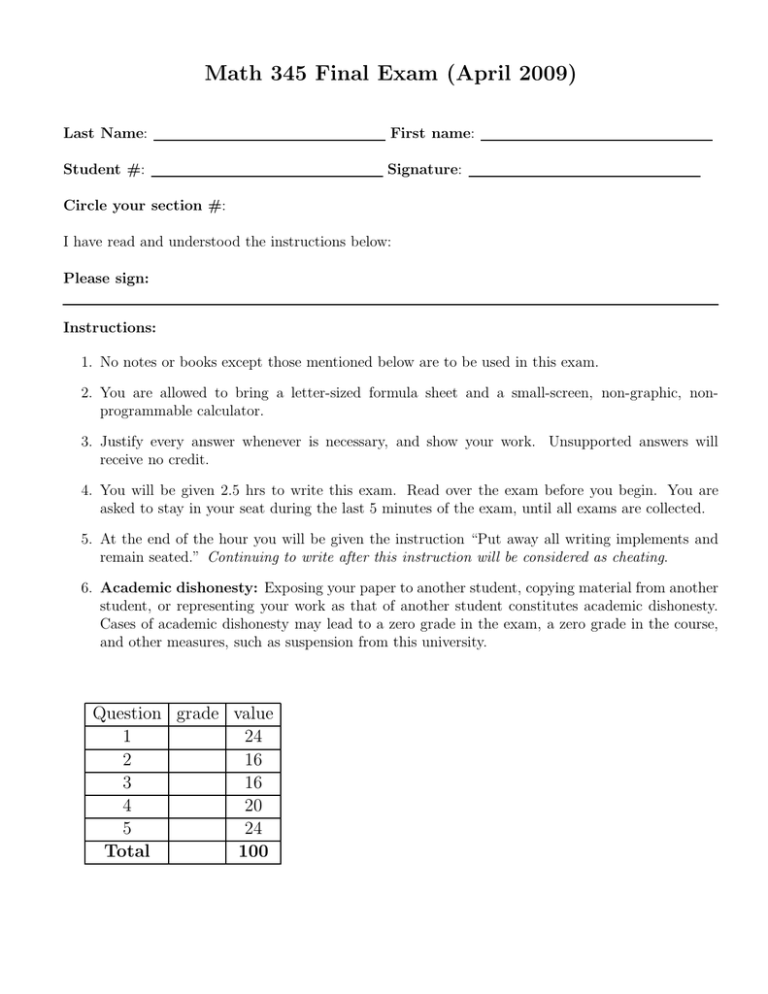
Math 345 Final Exam (April 2009)
Last Name:
First name:
Student #:
Signature:
Circle your section #:
I have read and understood the instructions below:
Please sign:
Instructions:
1. No notes or books except those mentioned below are to be used in this exam.
2. You are allowed to bring a letter-sized formula sheet and a small-screen, non-graphic, nonprogrammable calculator.
3. Justify every answer whenever is necessary, and show your work. Unsupported answers will
receive no credit.
4. You will be given 2.5 hrs to write this exam. Read over the exam before you begin. You are
asked to stay in your seat during the last 5 minutes of the exam, until all exams are collected.
5. At the end of the hour you will be given the instruction “Put away all writing implements and
remain seated.” Continuing to write after this instruction will be considered as cheating.
6. Academic dishonesty: Exposing your paper to another student, copying material from another
student, or representing your work as that of another student constitutes academic dishonesty.
Cases of academic dishonesty may lead to a zero grade in the exam, a zero grade in the course,
and other measures, such as suspension from this university.
Question grade value
1
24
2
16
3
16
4
20
5
24
Total
100
Math 345 Final
Name:
Question 1:
[24 marks]
Consider the one-dimensional differential equation
ẋ = f (x, r) = x(r − 2x − x2 ),
where the variable x(t) and the parameter r both belong to the real line R.
(a) Note that xs = 0 is a fixed point for all r. (i) Use linear stability analysis to show that its stability
changes at the bifurcation point (xs , rc ) = (0, 0). (ii) Determine the type of this bifurcation point (SN,
TC, or PF). The normal form is not required.
(b) (i) Find all fixed points for all possible values of r (clearly state the conditions under which they
exist). (ii) Plot the set Z = {(x, r) : f (x, r) = 0} (horizontal axis r, vertical axis x). (iii) Sketch all
the possible qualitatively different one-dimensional phase portraits for different values of r. (No need
to sketch the graph of ẋ versus x).
(c) Based on results obtained in (b)(iii) or any other method(s), determine the stability of each fixed
point in the plot obtained in (b)(ii). Sketch a bifurcation diagram (horizontal axis r, vertical axis x),
showing all fixed points. Draw the stable branch(s) of fixed points with solid curves and the unstable
branch(s) with dashed curves. (This diagram is identical in shape as that in (b)(ii) but is different only
in separating the stable from the unstable fixed points).
(d) There is another bifurcation point in addition to that in (a). (i) Determine the values of xs and rc
for this fixed point. (ii) Determine its type. (iii) Find its normal form.
Page 2 of 13
Math 345 Final
Name:
Question 2:
[16 marks]
Answer “True” or “False” to the statements below. Put your answers in the boxes.(4 mark each)
(a) A pitchfork bifurcation occurs in the equation ẋ = x +
rx
.
1 + x2
(b) The system ẋ = x(1 − x) − xy and ẏ = y(1 − y) − xy has no closed orbits.
(c) Consider a map xn+1 = f (xn ). A period-2 cycle is characterized by a pair of values p and q such
that f (p) = q and f (q) = p, where both p and q are roots of x = f 2 (x) = f (f (x)).
(d) Consider a map xn+1 = f (xn ). A period-2 cycle (characterized by f (p) = q and f (q) = p) is stable
if the multiplier λ = f ′ (p)f ′ (q) is positive valued.
Page 3 of 13
Math 345 Final
Name:
Question 3:
[16 marks]
These questions do not require lengthy calculations. Put your answers in the boxes.
(4 marks
each)
rx,
0 ≤ x ≤ 1/2
(a) For the tent map xn+1 = f (xn ) where f (x) =
, where r > 0 is a
r(1 − x), 1/2 ≤ x ≤ 1
parameter. Calculate the Liapunov exponent. Determine for what values of r the map has sensitive
dependence on initial conditions.
(b) For the two-dimensional system in polar co-ordinates ṙ = r(1 − r), θ̇ = 1 (where r 2 = x2 + y 2 and
x = r cos θ, y = r sin θ. Construct a Poincaré map at θ = 0 (i.e. a map that generates a series of r
values each time the trajectory goes through the line θ = 0).
(c) For what values of a, b is the function V (x, y) = ax2 + by 2 a Liapunov function of the system
ẋ = y − x3 and ẏ = −x − y 3 ?
(d) For the system ẋ = xy and ẏ = −x2 . Find a quantity E(x, y) that is conserved.
Page 4 of 13
Math 345 Final
Name:
Question 4:
[20 marks]
Consider the cubic map xn+1 = f (xn ) = rxn − x3n for the parameter r in R.
(a) Find all the fixed points and determine for which values of r do they exist.
(b) Determine the stability of the fixed points found in (a) as a function of r.
(c) Find all the period-2 cycles. (Hint: Suppose f (p) = q and f (q) = p. Show that p, q are roots of
the equation x(x2 − r + 1)(x2 − r − 1)(x4 − rx2 + 1) = 0.)
(d) Determine the stability of the period-2 cycles as a function of r.
(e) Plot a partial bifurcation diagram, based on the information obtained for −2 ≤ r ≤ 4.
Page 5 of 13
Math 345 Final
Name:
Question 5:
[24 marks]
Odell (1980) developed the following predator-prey model
ẋ = x[x(1 − x) − y],
ẏ = y(x − a),
where x ≥ 0 is the dimensionless population of the prey, y ≥ 0 is the dimensionless population of the
predator, and a ≥ 0 is a control parameter.
(a) Sketch the nullclines in the first quadrant x, y ≥ 0. Find all fixed points and mark each one by
a small circle in the phase plane.
(b) Classify each fixed point and determine if each one is hyperbolic or non-hyperbolic.
(c) For a = 1, use linear stability analysis to determine the stability of each fixed point. Sketch the
phase portrait for this case. Starting from a nonzero population size for both the predators and
the preys, determine what happens to the predators after a long time.
(d) Determine the critical value of a = ac where a Hopf bifurcation occurs.
(e) Construct a trapping region in the first quadrant x, y ≥ 0 within which there exists at least one
closed orbit for a < ac (ac is the value found in (d)). Sketch the shape of this region on the phase
plane. [Hint: Show that on the interval x ∈ (a, a + M) (for large enough M > 0) all flows on the
line y − M = −(x − a) are directed to ẋ < 0 and ẏ > 0 and that the ratio ẋ/ẏ < −1.]
Page 6 of 13
Math 345 Final
Name:
(More space for Question 5.)
Page 7 of 13
Math 345 Final
Name:
(More space for Question 5.)
Page 8 of 13
